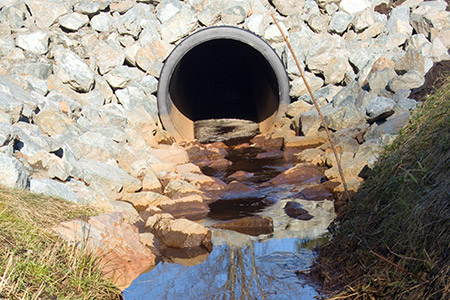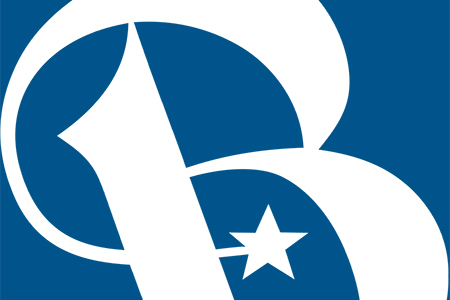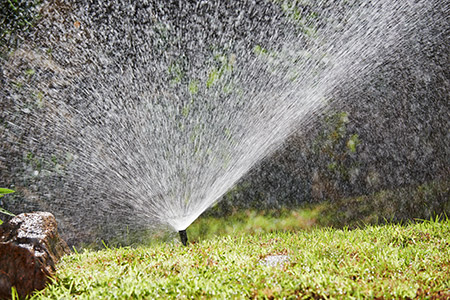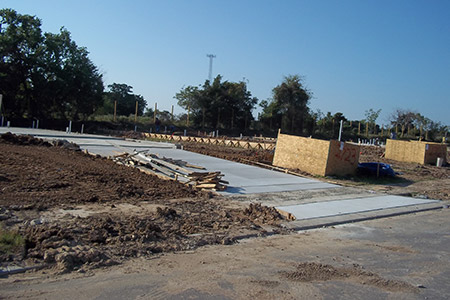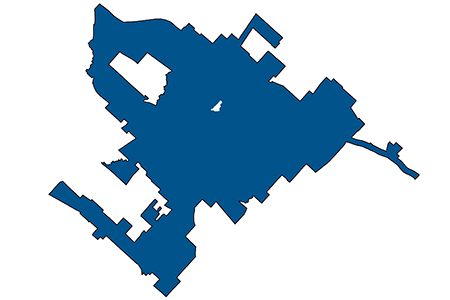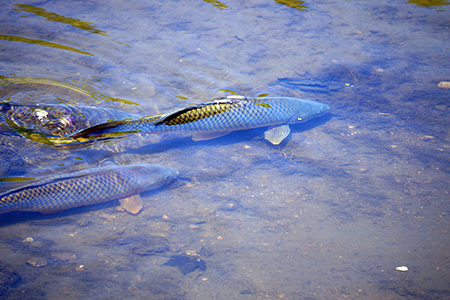Stormwater Management Program
What is Stormwater?
Stormwater is rain or melted snow that flows over surfaces such as lawns, driveways, parking lots, rooftops, and other developed areas. As it moves, this runoff collects pollutants like trash, oil, chemicals, and dirt, which are then carried into our creeks, rivers, streams, and lakes. These pollutants can contaminate drinking water, harm fish, kill aquatic life, and increase the cost of water treatment.
In urban areas, stormwater runoff often contains pesticides, fertilizers, pet waste, litter, food debris, automotive fluids, and other toxic materials commonly found in city environments. Water flowing over roads, parking areas, construction sites, and industrial zones picks up these pollutants and transports them through storm drain systems directly into Texas’s lakes, rivers, streams, and coastal waters.
Urban runoff is the leading source of unregulated pollution entering U.S. waterways and coastal regions. Locally, its effects are seen in elevated health risks for swimmers near storm drains, high levels of toxic metals in marine sediments, and harmful impacts on aquatic ecosystems.
The City of Bryan has created a Stormwater Management Program (SWMP) to meet State and Federal requirements and enhance the quality of life in our community. This program outlines actions designed to reduce pollution in stormwater runoff that flows into our local waterways.
Stormwater Management Program
This plan is the third renewal of the City of Bryan’s Stormwater Management Program as required by the Texas Commission on Environmental Quality. This plan runs from 2019-2024 and is an update of the existing plan adopted in 2014.
Quick Links
- Stormwater Master Plan
- Stormwater Management Ordinance
- MS4 Annual Report
- Stormwater Management Plan
- Keep It Clean brochure, (Also available in Spanish)
What’s the Difference Between a Storm Sewer and a Sanitary Sewer?
Sanitary sewers carry wastewater from homes and businesses—like water from sinks, toilets, and showers—to a treatment plant. There, it’s cleaned to meet or exceed EPA and TCEQ standards before being safely released into nearby creeks, rivers, or lakes.
Storm sewers, on the other hand, collect rainwater runoff from streets, parking lots, and other surfaces through storm drains. This water flows directly—without any treatment—into local waterways such as creeks, rivers, and lakes.
How the City Addresses These Issues:
Mapping the Storm Drain System
- Improved Detection of Pollution Sources – Mapping helps identify where stormwater flows and where pollutants may be entering the system, making it easier to trace and eliminate sources of contamination.
- Efficient Maintenance and Inspection – A detailed map allows for more effective scheduling of inspections, cleanings, and repairs to prevent blockages and reduce the risk of polluted runoff.
- Faster Response to Illicit Discharges – When illegal dumping or accidental spills occur, mapped systems allow for quick identification of affected areas and faster containment and cleanup.
- Public Education and Awareness – Maps can help educate residents and businesses about the drainage pathways near them, encouraging better practices to prevent pollution.
- Stormwater Planning and Infrastructure Upgrades – Accurate maps are essential for planning future improvements or expansions to the drainage system, ensuring better long-term management of runoff.
Conducting Dry Weather Screenings
- Identifies Illicit Discharges – During dry weather, stormwater systems should not have flowing water. Detecting flow during these conditions often signals illegal dumping or unauthorized connections, allowing for early intervention.
- Prevents Harmful Pollutants from Reaching Waterways – By identifying and stopping sources of pollution—such as sewage leaks, chemical discharges, or wastewater connections—before they enter the system, harmful contaminants are kept out of rivers, lakes, and streams.
- Improves System Understanding and Maintenance – Routine screenings can uncover unknown connections, deteriorated infrastructure, or improper drainage, helping cities update their stormwater maps and improve maintenance.
- Enables Targeted Pollution Prevention – Once pollution sources are identified, the city can focus education, enforcement, or cleanup efforts on specific areas, making pollution prevention more effective.
- Cost-Effective Pollution Control – Early detection and correction of problems reduce the need for costly cleanups, environmental restoration, or health interventions later on.
Investigating Reports of Illegal Dumping or Unauthorized Connections
- Stops Pollution at the Source – Investigations help quickly identify and eliminate sources of harmful substances—such as chemicals, oils, sewage, or debris—before they enter the storm drain system and pollute local waterways.
- Prevents Harm to Public Health and Wildlife – Many dumped materials contain toxic substances or bacteria that can harm people, pets, and aquatic life. Investigations help prevent these pollutants from reaching recreational waters and natural habitats.
- Deters Future Violations – Active investigation and enforcement discourage others from dumping waste or making illegal connections, fostering a culture of compliance and responsibility.
- Enhances Community Awareness and Engagement – Public reporting and visible investigations show that the city is committed to protecting local waterways, encouraging residents and businesses to report concerns and follow best practices.
- Improves Infrastructure Integrity – Unauthorized connections can overload or damage the storm drain system. Identifying and removing them helps maintain proper function and reduces costly repairs.
Promoting Household Hazardous Waste (HHW) Collection Events
- Reduces Improper Disposal of Harmful Substances – Many people unknowingly dispose of hazardous products—like paint, motor oil, pesticides, and cleaners—by pouring them down drains or into the trash. Collection events provide a safe, convenient alternative.
- Prevents Contaminants from Entering Storm Drains – Without proper disposal options, hazardous household products can end up on streets, driveways, or in yards, where rain can wash them into the storm drain system and eventually into local waterways.
- Protects Water Quality and Aquatic Life – Chemicals in household products can be toxic to fish, wildlife, and plant life. Proper collection keeps these pollutants out of streams, rivers, and lakes, helping maintain healthy ecosystems.
- Educates the Public on Proper Waste Handling – Promoting HHW events raises awareness about what qualifies as hazardous waste and how it should be managed, encouraging more responsible behavior year-round.
- Reduces Risk of Soil and Groundwater Contamination – Hazardous waste that’s dumped or buried improperly can seep into the soil and contaminate groundwater. Collection events help prevent this long-term environmental damage.
What You Can Do to Help
Report Issues
One meaningful way to help protect our water resources is by reporting environmental concerns.
A common issue is the improper disposal of household hazardous waste—such as paint, pesticides, or used motor oil—into the stormwater system. Other pollutants that frequently end up in our waterways include grass clippings, pet waste, trash, fertilizers, and even automotive fluids like antifreeze.
Illegal dumping, sanitary sewer overflows, and improper connections that route wastewater into the storm drain system instead of the sanitary sewer can also have serious consequences. These practices can harm wildlife, pollute drinking water, and contribute to the spread of disease.
You can report these concerns to the City of Bryan by phone or online using the Help Bryan issue reporting system.
- Report a Stormwater Issue
- Illicit discharges: Contact Solid Waste at 979-209-5900.
- Excessive sediment or erosion leaving a construction site: Contact Engineering Services at 979-209-5030.
Simple Ways to Protect Our Water
-
Avoid fertilizing before a storm. Fertilizer needs at least a day or two to soak into your lawn. Applying it just before rain means it will likely wash into storm drains, polluting our waterways. Always follow the product’s instructions and use only the amount recommended for your lawn size.
-
Never use motor oil, gasoline, or kerosene to control weeds or pests. These toxic substances can easily wash into creeks and rivers, harming water quality and wildlife.
-
Use pesticides sparingly. Try non-toxic or low-toxicity options first, and remember that not all bugs are bad—some are beneficial for your garden.
-
Plant native or drought-tolerant species. Texas Smartscape plants are well-suited for our climate, need less water and maintenance, and typically don’t require pesticides to thrive.
-
Water wisely with the cycle and soak method. Our clay-heavy soil doesn’t absorb water quickly. Try watering in shorter cycles with breaks in between to allow water to soak in and reduce runoff.
-
Pick up pet waste. Always bag pet waste and throw it in the trash. Left on the ground, it can wash into storm drains, carrying bacteria into local waterways. It’s not a safe or effective lawn fertilizer.
-
Properly dispose of yard trimmings. Sweep and bag leaves and grass clippings in large paper yard bags. Place them three feet from your trash cart on your regular collection day. Never blow or wash yard waste into streets or storm drains—keeping them clear helps prevent flooding. With thousands of storm drains in Bryan, your help makes a big difference!
-
Collect rainwater. Use a rain barrel to capture runoff from your roof and reuse it on dry days. The Brazos Valley Groundwater Conservation District even offers a rebate for installing a rain barrel.
Protecting Water While Maintaining Your Vehicle
-
Avoid washing your car in the driveway. When you wash your car at home, soapy water, along with oil, dirt, and grime, can flow into storm drains and eventually pollute our local waterways.
-
Choose a commercial car wash instead. Professional car wash facilities are equipped to recycle wash water and send it to the sanitary sewer system, where it gets properly treated.
-
Fix vehicle leaks promptly. Leaking fluids like oil, coolant, and brake fluid can harm the environment. Repairing leaks quickly helps prevent these substances from washing into storm drains.
-
Recycle used car fluids and parts responsibly. Take used oil, oil filters, and antifreeze to an auto service center that accepts these materials. You can also drop them off at the Environmental Collection Center. Visit their website for more information.
-
Recycle car batteries. Most auto parts stores and battery retailers accept old batteries for recycling. Note that some may charge a small fee for this service.
-
Store auto parts properly. Keep spare parts and tools in a covered area to prevent oil and grease from being washed away by rain and entering the stormwater system.
Boating Responsibly to Protect Water Quality
-
Handle gasoline with care. Always take extra caution when fueling to prevent spills on the ground or in the water, as even small amounts can be harmful.
-
Never litter in or near water. Trash left behind can break down and release toxins that damage water quality and harm wildlife. Items like fishing line and six-pack rings are especially dangerous to fish, birds, and other aquatic animals.
-
Maintain your boat engine. Check it regularly and repair any oil leaks right away to prevent pollution.
-
Use minimal soap when cleaning your boat. Rinse and scrub with a brush whenever possible. If soap is needed, choose a non-toxic, phosphate-free product and use it sparingly. Wash your boat in areas where runoff won’t reach storm drains or natural waterways.
-
Dispose of paint debris properly. When removing paint from your boat’s hull, use a drop cloth to catch scrapings or sweep them up and place them in the trash. Many bottom paints contain copper or tin, which are toxic to aquatic life and degrade water quality.
MS4 Annual Reports
On April 10, 2007 the City of Bryan adopted a Flood Mitigation Plan to create a strategy for implementing flood mitigation measures for the community. The plan identified several items for floodplain planning that the city has worked on implementing. These items include:
- Minimize losses due to flooding and achieve a balance between natural open space and improvements for drainage
- Preserve and protect unique open spaces, river corridors, drainage corridors and green spaces within the City and its Extraterritorial Jurisdiction
- Develop a network of pedestrian and bicycle ways for hiking and cycling throughout Bryan
Each year this progress report will be required as part of the City’s Community Rating System annual recertification process and must be provided to the Bryan City Council and made available to the news media and the public. The report will be produced on the City’s web page to facilitate this requirement. The intent of this report is to give a brief update on the City’s progress with respect to each of these items and to expand on the city’s future progress.
- MS4 2024 Annual Report
- MS4 2023 Annual Report
- MS4 2022 Annual Report
- MS4 2021 Annual Report
- MS4 2020 Annual Report
- MS4 2019 Annual Report
- MS4 2018 Annual Report
- MS4 2017 Annual Report
- MS4 2016 Annual Report
- MS4 2015 Annual Report
- MS4 2014 Annual Report
Stormwater Quality Outreach
Preventing stormwater pollution requires everyone in the community to do their part in keeping pollutants out of storm drain inlets near their homes and workplaces. You can help by staying informed, fixing leaks and spills, and reporting any pollution you observe.
Improving Our Water Quality
This brochure is also available in Spanish.
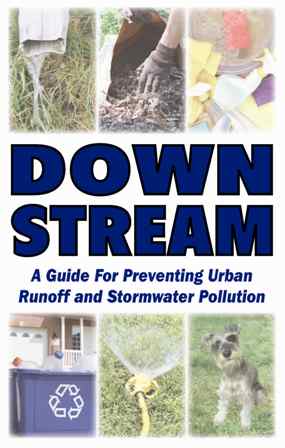
Controlling Construction Site Runoff
Why Is Monitoring Construction Activities Important?
During construction or land clearing, dirt, debris, and waste materials can be washed into the City’s storm drainage system when it rains. Unlike sanitary sewer systems, storm drains do not treat water—so any pollutants carried by runoff flow directly into local creeks, rivers, and lakes. This can degrade water quality and harm aquatic life.
What’s the Solution?
The most effective way to prevent pollution is to keep soil, trash, and construction materials contained at the construction site. This requires proper planning and the use of straightforward, reliable erosion and sediment control practices.
Compliance Requirements
To meet the City of Bryan’s Stormwater Management Ordinance, certain construction sites must:
-
Apply for a Grading Permit
-
Possibly obtain a TPDES Construction General Permit
The Texas Pollutant Discharge Elimination System (TPDES) Construction General Permit, in effect since March 5, 2003, is managed by the Texas Commission on Environmental Quality (TCEQ). It authorizes the discharge of stormwater runoff from:
-
Large construction sites (over 5 acres)
-
Small construction sites (between 1 and 5 acres)
Below, you’ll find additional details about the TPDES permit and helpful resources from the TCEQ, EPA, and other organizations.
- Texas Commission on Environmental Quality (TCEQ) Assistance Tools
- TCEQ State of Texas Environmental Electronic Reporting System (STEERS)
- Notice of Intent (NOI)
- Notice of Termination (NOT)
- Best Management Practices for General Construction & Site Supervision to Improve Stormwater Quality Brochure
Construction Stormwater Management
Best Management Practices (BMPs) in this category are intended to control stormwater runoff from construction sites that are one acre or larger. The Texas Commission on Environmental Quality (TCEQ) requires construction site operators to develop and follow a Stormwater Pollution Prevention Plan (SWPPP) in accordance with the Construction General Permit. To support compliance, the City enforces ordinances and procedures that align with state regulations. Additionally, the City will provide outreach and training to local developers and builders through a stakeholder committee and educational programs.
Bryan’s Stormwater Management Program contains six BMPs in the Construction Site Stormwater Runoff Control category:
- C-1 : Strengthen Erosion Control Ordinance
- C-2 : Erosion Control Plan Review Procedures
- C-3 : Construction Inspection
- C-4 : Developer’s Stakeholder Meetings
- C-5 : Construction General Permit Training
- C-6 : Stormwater Hotline for Public Comment
Construction projects often begin with clearing vegetation and grading the land to prepare for building. In subdivision developments, this process can leave large areas of bare soil exposed to rainfall. Without ground cover, these sites are highly susceptible to erosion. Rainwater can carry sediment off-site and into streets, storm drains, ponds, streams, and lakes, resulting in cloudy water. This sediment not only reduces visibility but also blocks sunlight from reaching aquatic plants and can smother bottom-dwelling insects and fish, disrupting the aquatic ecosystem.
Post-Construction Stormwater Management
Best Management Practices (BMPs) in this category focus on managing stormwater runoff from newly developed or redeveloped areas. Unlike temporary construction-phase BMPs, post-construction BMPs are permanent installations designed to control pollution after a project is completed. These practices should be integrated into development plans and include provisions for their long-term operation and maintenance.
The City of Bryan’s Stormwater Management Program includes four key BMPs under the Post-Construction Stormwater Management category:
- PC-1 : Developer’s Stakeholder Meetings
- PC-2 : Post Construction Ordinance
- PC-3 : Long Term Operation and Maintenance of BMPs
- PC-4 : List of Water Quality CIP Projects
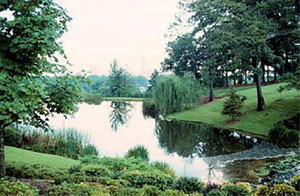
Research has shown that stormwater runoff from urbanized areas can carry substantial pollutants into nearby water bodies. The increase in impervious surfaces—such as rooftops, roads, and parking lots—leads to greater volumes of runoff, often containing high levels of sediment, nutrients, pesticides, heavy metals, harmful bacteria, and petroleum-based pollutants. These contaminants negatively affect aquatic ecosystems.
To reduce these impacts, BMPs should be implemented to treat, store, and infiltrate stormwater on-site before it reaches downstream waterways. Effective strategies may include innovative site design that minimizes impervious surfaces, along with low-impact development (LID) practices that improve water quality and reduce runoff.
City Inspections
The City of Bryan conducts inspections both during and after construction to ensure compliance with the Stormwater Management Ordinance.
Stormwater Inspection Checklist
This checklist guides City inspections and includes:
-
Verification of the Notice of Intent (NOI), Site Notice (small or large), and Stormwater Pollution Prevention Plan (SWPPP or SWP3) or Erosion Control Plan (ECP)
-
Evaluation of Best Management Practices (BMPs)
-
Identification of illicit connections or discharges
-
Assessment of overall compliance with City ordinances and the Texas Pollutant Discharge Elimination System (TPDES) stormwater permit requirements
Construction site owners and operators must provide inspectors with reasonable access for inspection, surveillance, and monitoring. The City may inspect sites periodically or in response to complaints.
Builder/Contractor Resources
Stormwater Pollution Prevention Plan (SWPPP) examples for use in construction of new residential and commercial development:
TCEQ checklists for stormwater pollution prevention plans:
Construction Control documents:
- Construction Control Selection Guide with Schematics
- Most-Used Construction Controls and Specifications
Vegetation Requirements for New Homes
Since 2003, the Texas Commission on Environmental Quality (TCEQ) Construction General Permit TXR150000 has required final vegetation stabilization on home building sites in Bryan. These same requirements are incorporated into the City of Bryan’s Code of Ordinances, Chapter 46: Stormwater Management.
In recent years, both the TCEQ and the Environmental Protection Agency (EPA) have increased enforcement of these stormwater regulations. As a result, Texas homebuilders have faced tens of thousands of dollars in fines for failing to comply with the Construction General Permit TXR150000.
Stabilization Requirements
Under this permit, construction site operators must stabilize all disturbed areas—including residential lots—with vegetation or other erosion control measures as soon as practicable, but no later than the end of the next workday after construction activities have temporarily or permanently ceased, as detailed in Part III, Section G of the permit.
Failure to meet these stabilization requirements can result in regulatory action and significant penalties.
For detailed information, see the full permit here:
2023 Construction General Permit TXR150000 (TCEQ)
Practical Application for Homebuilders
To obtain a Certificate of Occupancy for a new home, all disturbed areas during construction must be stabilized with vegetation. This includes not only the building site itself but also any adjacent lots that were disturbed for access, fencing, brick or stone work, or other construction-related activities.
Homebuilders are encouraged to minimize clearing and disturbance to only what is essential for construction. Stabilization measures should be implemented as soon as possible after soil disturbance to prevent erosion.
Vegetation Stabilization Options
-
Sodding: Provides immediate soil stabilization and is recommended for critical areas or where seeding may be difficult. Sod may be planted in a checkerboard pattern, provided bare patches are less than 42 inches in diameter and no more than 30% of the area remains bare.
-
Ground Cover Seeding and Fertilizing: Suitable for flat, non-sensitive areas with favorable soil conditions.
-
Xeriscaping: Landscaping designed to minimize or eliminate the need for supplemental irrigation water.
-
Low Impact Development (LID): Stormwater management strategies that use non-structural and structural methods to reduce runoff by preserving or mimicking the site’s natural pre-development hydrology.
According to the TCEQ Construction General Permit, once erosion controls are removed for irrigation or landscaping, vegetation stabilization must occur no later than the end of the next business day.
If sodding is not feasible at the time a Certificate of Occupancy is requested—such as during hot summer months—then stormwater controls must remain in place to prevent erosion until sod can be properly installed and maintained.
Builder to Homeowner Transfer of Stormwater Responsibility
To release homebuilders from ongoing responsibility for stormwater controls after home construction is complete, the City of Bryan offers a Builder to Homeowner Transfer Notice. This temporary measure allows the homebuilder to obtain a Certificate of Occupancy, and the homeowner to take possession of the home, while final site stabilization—such as vegetation—is pending.
The notice must:
-
Be signed by both the homebuilder and homeowner
-
Clearly identify the stormwater controls that will be installed on the site to prevent erosion
-
Ensure that site stabilization is completed within two months of the transfer date
If the site is not stabilized within this timeframe, the homeowner will be in violation of City of Bryan and TCEQ regulations and may face enforcement actions or fines.
The Construction General Permit TXR150000 requires the City of Bryan to implement a Stormwater Management Plan (SWMP) and submit an annual compliance report to the Texas Commission on Environmental Quality (TCEQ). This plan outlines how the City addresses pollution prevention, construction site runoff control, and post-construction stormwater management.
As noted earlier, failure to comply with stormwater management requirements can result in state or federal penalties—not only for homebuilders and homeowners but also for the City itself if the SWMP is not properly followed.
To help avoid these consequences, City of Bryan staff are committed to supporting builders and homeowners in planning, implementing, and maintaining effective stormwater management practices.
For additional information please see:
- TCEQ Template for Stormwater Pollution Prevention Plan
- Stormwater Requirements for Construction Activities
- Bryan Code of Ordinances, Chapter 46, Stormwater Management
- Best Management Practices
- Xeriscape Water Conservation (Aggie Horticulture)
Stormwater Frequently Asked Questions
Have questions about stormwater? We’ve put together some helpful answers to explain how we manage it and keep our community safe.
What is stormwater?
Stormwater is rain that does not absorb into the soil and runs off of buildings, roads and other surfaces into stormwater systems, streams, creeks and rivers.
What is a Stormwater Management Program (SWMP)?
A SWMP is a plan that outlines how a city will reduce stormwater pollution. A SWMP consists of Best Management Practices that are grouped into six categories.
- Public Education and Outreach
- Public Participation and Involvement
- Illicit Discharge Detection and Elimination
- Construction Site Stormwater Runoff Control
- Post Construction Stormwater Management
- Pollution Prevention / Good Housekeeping for Municipal Operations
Why did the City of Bryan develop a SWMP?
The City of Bryan developed a Stormwater Management Program (SWMP) to comply with State and Federal regulations and improve the quality of life in our city. The City’s SWMP contains activities or Best Management Practices (BMPs) to reduce the amount of pollution in the stormwater that runs off into our streams.
How do I find out what BMPs have been implemented and what BMPs will be implemented in the future?
The City’s SWMP is available online. The City produces an annual report, which is due to the Texas Commission on Environmental Quality (TCEQ) on November 10th each year. These annual reports outline the status of BMP implementation and describe what BMPs are anticipated for the next reporting cycle. The City’s annual reports are available on the Stormwater web page.
What Challenges Does the City Face in Managing Stormwater?
Managing stormwater isn’t always easy. Some of the main challenges include:
- Too much pavement and not enough green space, which means more runoff and less water soaking into the ground.
- Keeping pollution out of the storm drains, since water picks up trash, oil, and chemicals as it flows over streets and parking lots.
- Preventing flooding during heavy rain events when the drainage system can get overwhelmed.
- Maintaining infrastructure, like storm pipes, ditches, and inlets, which need regular cleaning and repairs.
- Balancing growth and development while protecting creeks, rivers, and water quality.
That’s why the City works to educate the public, enforce stormwater regulations, and invest in better drainage infrastructure.
What is the City Doing to Minimize the Impact of Stormwater?
The City of Bryan carries out several important measures to address stormwater challenges:
- Inspection and Prevention: City staff regularly inspect construction sites to ensure proper controls are in place to minimize runoff.
- Planning and Engineering: City engineers review design and construction plans to evaluate their impact on stormwater.
- Infrastructure Construction and Maintenance: Engineers and maintenance crews work to build new stormwater systems and maintain existing infrastructure.
What is a Stormwater Management Program (SWMP)?
A SWMP is a plan that outlines how a city will reduce stormwater pollution. A SWMP consists of Best Management Practices that are grouped into six categories.
- Public Education and Outreach
- Public Participation and Involvement
- Illicit Discharge Detection and Elimination
- Construction Site Stormwater Runoff Control
- Post Construction Stormwater Management
- Pollution Prevention / Good Housekeeping for Municipal Operations
Why did the City of Bryan develop a SWMP?
The City of Bryan developed a Stormwater Management Program (SWMP) to comply with State and Federal regulations and improve the quality of life in our city. The City’s SWMP contains activities or Best Management Practices (BMPs) to reduce the amount of pollution in the stormwater that runs off into our streams.
How do I find out what BMPs have been implemented and what BMPs will be implemented in the future?
The City’s SWMP is available online. The City produces an annual report, which is due to the Texas Commission on Environmental Quality (TCEQ) on November 10th each year. These annual reports outline the status of BMP implementation and describe what BMPs are anticipated for the next reporting cycle. The City’s annual reports are available on the Stormwater web page.
What is Impervious Cover and Why Does It Matter?
Impervious cover includes surfaces that don’t let water soak in—like pavement, rooftops, and driveways. When it rains, water can’t absorb into the ground and instead runs off quickly, flowing over these surfaces and straight into the storm drain system. This can lead to:
- Increased flooding – because storm drains can get overwhelmed by the volume of runoff.
- More erosion – as fast-moving water wears down stream banks and channels.
- Water pollution – runoff picks up oil, trash, chemicals, and debris from streets and carries them directly to local creeks and rivers.
- Reduced groundwater recharge – since water can’t soak into the ground, less makes its way into underground aquifers.
In short, the more impervious cover in an area, the greater the strain on the drainage system.
What types of pollution are found in stormwater?
A: Some of the most common contaminants that are found in stormwater are listed below. For more information see About Stormwater.
- Sediment from eroded soil and construction sites
- Excess nutrients from lawn fertilizers
- Excess organic matter from leaf and grass clippings
- Bacteria and disease causing organisms from pet waste or raw, untreated sewage
- Debris /Trash such as plastic bags, cans, bottles, and cigarette butts
- Household chemicals like insecticides, pesticides, paint, solvents, used motor oil, and other auto fluids
- Metal particles deposited on roadways from automobiles
Are sewers and storm drains the same thing?
No. They are two completely separate drainage systems. Effluent in the sewer system receives extensive and thorough filtration prior to being discharged. The storm drain system on the other hand, receives no filtration whatsoever, and discharges directly into the local creeks untreated.
Where does my stormwater go?
Stormwater runoff from Bryan flows to one of the following creeks:
- Briar Creek
- Burton Creek
- Carter’s Creek
- Cottonwood Creek
- Still Creek
- Thompson’s Creek
- Turkey Creek
If it only affects streams and creeks, why should I care?
Streams and creeks feed into rivers, lakes and eventually the ocean. We all drink water, so we are all affected when our water is polluted. When water treatment costs rise, the price of drinking water goes up. If you like to fish, swim or boat, you may have heard or been affected by advisories warning you not to swim, fish or boat in a certain area because of unhealthy water or too much algae. Shellfish like clams, oysters, and shrimp cannot be harvested from polluted waters, so anyone that enjoys these foods or makes a living from the shellfish industry is affected. Money made from tourism and water recreation can also be impacted, as are businesses and home flooded by stormwater runoff. When we pollute our water, everyone is affected!
Why doesn’t the City build a stormwater treatment facility?
Such a facility would be extremely costly to build and maintain. And, the massive amount of water coming through the facility during a rainstorm would easily overtax the system.
Can I dispose of used motor oil on the ground or in the garbage?
NEVER dispose used motor oil on the ground; in a ditch, creek, river, or lake; in a storm drain; or in the garbage. It’s against the law. Texas law prohibits dumping used oil on land or into sewers or waterways. Texas has also banned used oil filters from being placed in or accepted for disposal in a landfill. Just one improperly disposed oil change can contaminate up to one million gallons of fresh water. Even small amounts can pollute large areas and threaten aquatic life.
Where can I take my used motor oil?
The City encourages citizens to take their used motor oil to the Municipal Services Center (1111 Waco Street) or to any local auto maintenance shop in Bryan. These auto shops are conveniently located and will take the used oil free of charge. Quantities of less than five gallons from non-commercial users will be accepted at any auto service shop. For the location of a used oil/used oil filter collection center near you, call 1-800-CLEANUP, or visit Earth911.org to search for recycling locations by Zip Code.
What are Household Hazardous Chemicals?
Many common household chemicals are dangerous to our kids, pets, and the environment. These materials may pollute our waterways if washed or dumped into storm drains or roadside ditches that lead directly to our streams and lakes. Household cleaners, pesticides, gasoline, antifreeze, used motor oil, and other hazardous products should to be labeled, stored, and disposed of properly.
Where can I dispose of Household Hazardous Chemicals?
The City provides free disposal of household hazardous chemicals to its residents. See the Household Chemical Disposal web page for disposal procedures or Bryan’s Environmental Services Department web page for safer alternatives.
Is it okay to let things like leaves and grass clippings wash into the storm drain?
No, natural items like leaves and grass clippings should not go in the storm drain.
Even though they’re natural, they can clog the drainage system and contribute to water pollution. When organic materials break down in waterways, they can use up oxygen that fish and other aquatic life need to survive. Instead, compost them or bag them for proper disposal.
Who do I call if I see anyone illegally dumping into the storm drain?
Call the City of Bryan’s Stormwater Hotline at (979) 209-5900 to submit an anonymous report if you observe any of the following:
- Illegal dumping of trash and debris along roadways or in creeks
- Leaking automobiles
- Concrete dumped in the street or storm drain
- Paint dumped in storm drain
- Motor oil dumped in storm drain
- Sediment runoff from construction sites
- Yard clippings blown or swept into storm drains
- Sewage or septic tank leaks
What is a Municipal Separate Storm Sewer System (MS4)?
The regulatory definition of an MS4 (40 CFR 122.26(b)(8)) is “a conveyance or system of conveyances (including roads with drainage systems, municipal streets, catch basins, curbs, gutters, ditches, man-made channels, or storm drains): (i) Owned or operated by a state, city, town, borough, county, parish, district, association, or other public body (created to or pursuant to state law) including special districts under state law such as a sewer district, flood control district or drainage district, or similar entity, or an Indian tribe or an authorized Indian tribal organization, or a designated and approved management agency under section 208 of the Clean Water Act that discharges into waters of the United States. (ii) Designed or used for collecting or conveying stormwater; (iii) Which is not a combined sewer; and (iv) Which is not part of a Publicly Owned Treatment Works (POTW) as defined at 40 CFR 122.2.”
In practical terms, operators of MS4s can include municipalities and local sewer districts, state and federal departments of transportation, public universities, public hospitals, military bases, and correctional facilities. The Stormwater Phase II Rule added federal systems, such as military bases and correctional facilities by including them in the definition of small MS4s.
